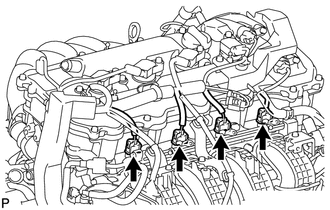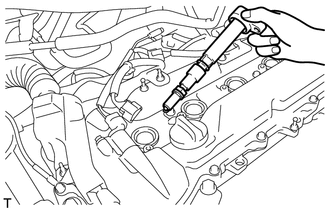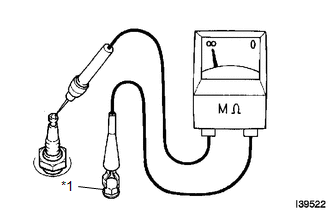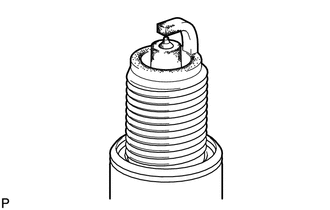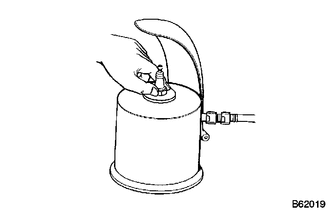Toyota Venza: On-vehicle Inspection
ON-VEHICLE INSPECTION
PROCEDURE
1. PERFORM SPARK TEST
(a) Check for DTCs (See page .gif) ).
).
NOTICE:
If any DTC is output, perform troubleshooting procedures for that DTC.
(b) Remove the ignition coils and spark plugs (See page
.gif) ).
).
|
(c) Disconnect the 4 injector connectors. |
|
(d) Install the spark plug into the ignition coil, and then connect the ignition coil connector.
|
(e) Ground the spark plug. |
|
(f) Check that spark occurs at each spark plug while the engine is being cranked.
NOTICE:
- Be sure to ground the spark plugs when checking them.
- Do not crank the engine for more than 2 seconds.
Cranking will stop if the engine switch is pushed again for models with cranking holding function.
- If a spark plug has been struck or dropped, replace it.
- If an ignition coil assembly has been struck or dropped, replace it.
HINT:
If spark does not occur for any cylinder, perform the following Inspect Ignition Coil and Spark Test procedure.
(g) Connect the 4 fuel injector connectors.
(h) Install the spark plugs and ignition coils (See page
.gif) ).
).
(i) Check for DTCs (See page .gif) ).
).
(j) Clear the DTCs (See page .gif) ).
).
2. INSPECT IGNITION COIL AND SPARK TEST
HINT:
Perform "Inspection After Repair" after replacing the spark plug and ignition
coil assembly (See page .gif) ).
).
(a) Check that the wire harness side connector of the ignition coil with igniter is securely connected.
Result|
Result |
Action |
|---|---|
|
NG |
Connect securely |
|
OK |
Go to next step |
(b) Perform a spark test on each ignition coil.
(1) Replace the ignition coil with a known good one.
(2) Perform the spark test again.
Result|
Result |
Action |
|---|---|
|
NG |
Go to next step |
|
OK |
Replace ignition coil |
(c) Perform a spark test on each spark plug.
(1) Replace the spark plug with a known good one.
(2) Perform the spark test again.
Result|
Result |
Action |
|---|---|
|
NG |
Inspect the ignition system (See page
|
|
OK |
Replace spark plug |
3. CHECK SPARK PLUG
NOTICE:
- Do not use a wire brush for cleaning.
- Do not attempt to adjust the electrode gap of a used spark plug.
HINT:
Perform "Inspection After Repair" after replacing the spark plug (See page
.gif) ).
).
|
(a) Check the electrode using a megohmmeter: Text in Illustration
(1) Using a megohmmeter, measure the insulation resistance. Standard Insulation Resistance:
HINT:
|
|
|
(b) Alternative inspection method: (1) Quickly accelerate the engine to 4000 rpm 5 times. (2) Remove the spark plug (See page (3) Visually check the spark plug. If the electrode is dry, the spark plug is functioning properly. If the electrode is damp, proceed to the next step. (4) Install the spark plug (See page
|
|
(c) Check the spark plug for any damage to its thread and insulator.
If there is any damage, replace the spark plug.
Recommended Spark Plug:
|
Manufacturer |
Spark Plug Type |
|---|---|
|
DENSO |
SK16HR11 |
(d) Reference:
|
(1) Check the spark plug electrode gap. Maximum electrode gap for a used spark plug: 1.3 mm (0.0512 in.) If the gap is more than the maximum, replace the spark plug. NOTICE: Never attempt to adjust the gap of a used plug. Electrode gap for a new spark plug: 1.0 to 1.1 mm (0.0394 to 0.0433 in.) Text in Illustration
|
|
|
(e) Clean the spark plugs. If the electrode has traces of wet carbon, clean the electrode with a spark plug cleaner and then dry it. Standard air pressure: 588 kPa (6 kgf/cm2, 85 psi) Standard duration: 20 seconds or less HINT: Only use a spark plug cleaner when the electrode is free of oil. If the electrode has traces of oil, use gasoline to clean off the oil before using the spark plug cleaner. |
|
 System Diagram
System Diagram
SYSTEM DIAGRAM
...
 Knock Sensor
Knock Sensor
Components
COMPONENTS
ILLUSTRATION
Removal
REMOVAL
PROCEDURE
1. REMOVE INTAKE MANIFOLD
(a) Remove the intake manifold (See page ).
2. REMOVE KNOCK SENSOR
(a) Disconnect the ...
Other materials about Toyota Venza:
Removal
REMOVAL
PROCEDURE
1. DISCONNECT CABLE FROM NEGATIVE BATTERY TERMINAL
CAUTION:
Wait at least 90 seconds after disconnecting the cable from the negative (-)
battery terminal to disable the SRS system.
NOTICE:
When disconnecting the cable, some systems ne ...
Customize Parameters
CUSTOMIZE PARAMETERS
1. CUSTOMIZING FUNCTION WITH TECHSTREAM
HINT:
The following items can be customized.
NOTICE:
When the customer requests a change in a function, first make sure that
the function can be customized.
Be sure to make a not ...
Precaution
PRECAUTION
1. PRECAUTION FOR VEHICLE WITH SRS AIRBAG AND SEAT BELT PRETENSIONER
(a) Some operations in this section may affect the SRS airbags. Prior to performing
the corresponding operations, read the precautions regarding the SRS airbags (See
page ). ...
0.1493

